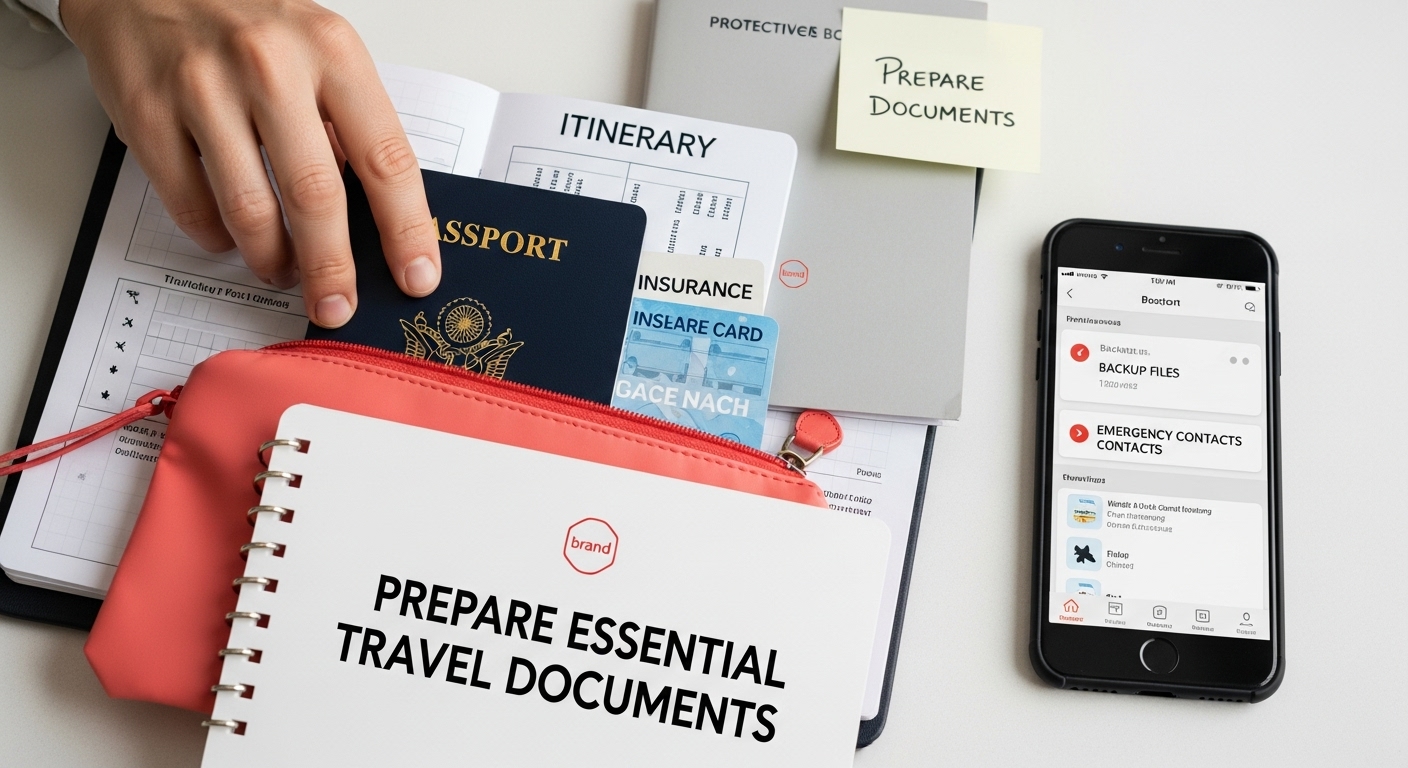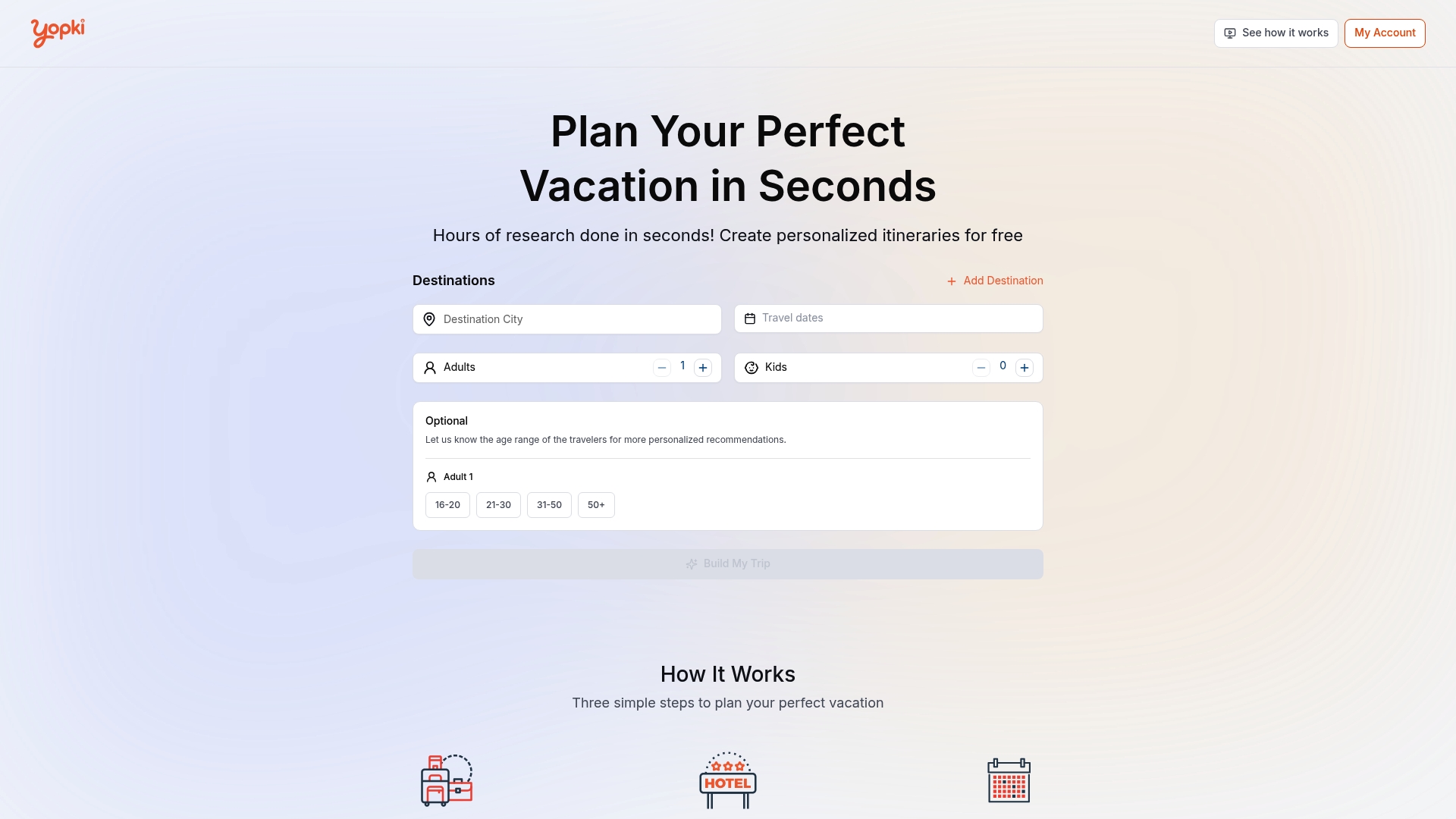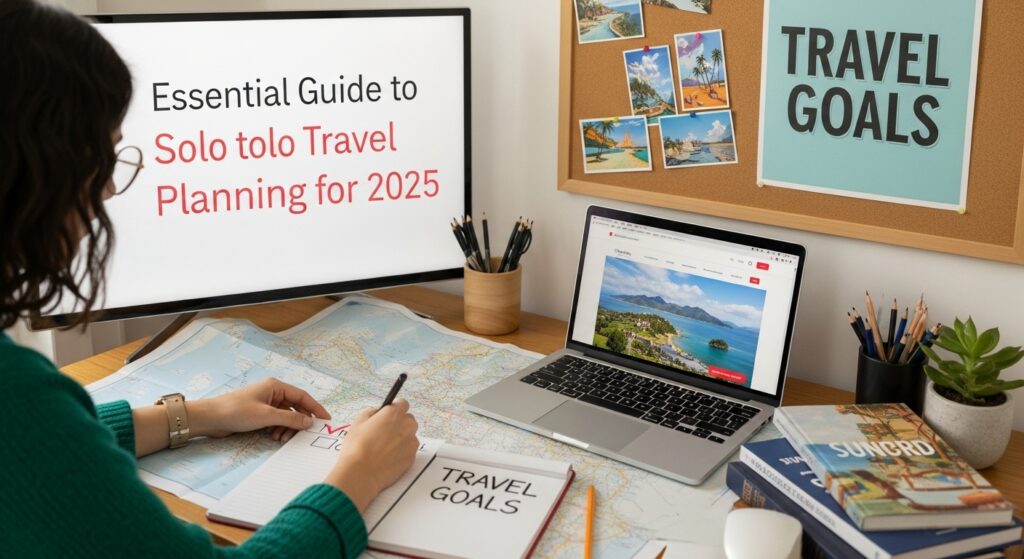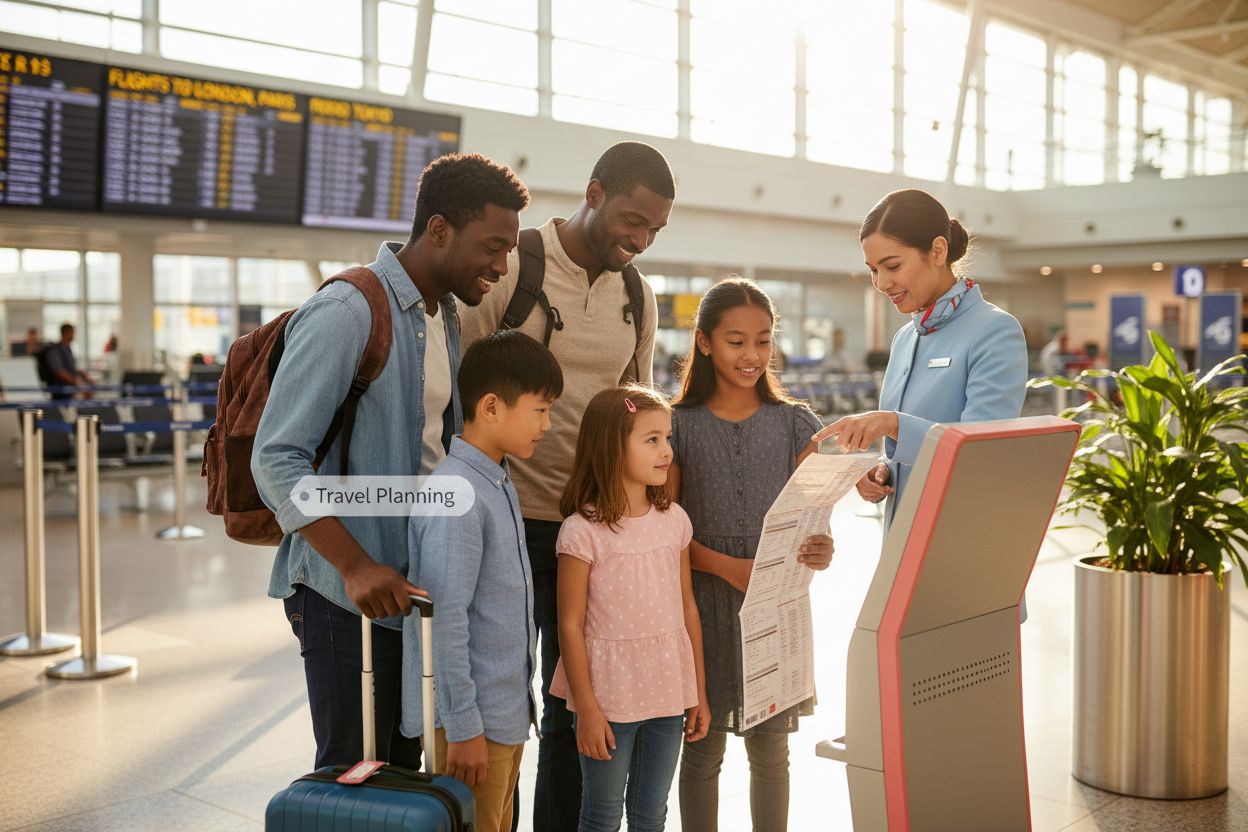Planning a solo trip sounds exciting and just a little intimidating. Statistics show that more than 25 percent of travelers now take at least one solo adventure each year. You might expect the biggest challenges to be picking a spot or booking flights. What actually makes all the difference is what you do before you even leave home and the right prep can turn anxious guesswork into the best experience of your life.
Table of Contents
- Step 1: Define Your Travel Goals And Destinations
- Step 2: Create A Detailed Budget And Timeline
- Step 3: Research Accommodations And Transportation Options
- Step 4: Plan Your Itinerary And Activities
- Step 5: Prepare Essential Travel Documents And Safety Measures
- Step 6: Review Your Plan And Make Final Adjustments
Quick Summary
| Key Point | Explanation |
|---|---|
| 1. Define Clear Travel Goals | Establish what you want from your solo travel to guide your planning and choices. |
| 2. Create a Detailed Budget | Outline your total funds and expenses, ensuring to set aside a contingency fund for emergencies. |
| 3. Research Accommodations and Transport | Analyze different lodging and transportation options for safety, convenience, and budget adherence. |
| 4. Develop a Flexible Itinerary | Create a day-by-day plan that includes must-see attractions while allowing for spontaneous adventures. |
| 5. Prepare Essential Documents and Safety | Ensure all travel documents are valid, secure, and backed up, while also researching safety measures for your destination. |
Step 1: Define Your Travel Goals and Destinations
Solo travel planning begins with establishing a clear vision for your journey. This foundational step transforms a vague desire to travel into a concrete, actionable adventure. Your travel goals serve as the compass that guides every subsequent decision in your trip preparation.
Start by reflecting deeply on what you truly want from this solo experience. Are you seeking personal growth through cultural immersion? Craving adventure and physical challenges? Wanting relaxation and escape from daily routines? Your authentic motivation will shape your entire travel strategy.
Consider creating a personal travel profile that captures your interests, comfort levels, and aspirations. This might include preferred travel styles like backpacking, luxury exploration, cultural tours, or wellness retreats. Factor in your current life stage, fitness level, and personal boundaries. Some travelers prefer structured experiences with guided tours, while others thrive on spontaneous exploration.
Check out our comprehensive trip planning guide to help refine your travel vision. When selecting destinations, balance your dreams with practical considerations. Research potential locations thoroughly, examining factors like safety for solo travelers, local transportation infrastructure, language barriers, and cultural compatibility with your travel style.
Utilize online resources, travel forums, and solo traveler communities to gather insights. Look for destinations that align with your goals while matching your comfort zone and budget. Some travelers might start with more manageable solo destinations before attempting more challenging international trips.
Key verification points for completing this step include:

- A clear, written statement of your travel goals
- A shortlist of 2-3 potential destinations matching those goals
- Basic research completed on each potential destination
- An initial assessment of your personal travel readiness
Remember that solo travel planning is an iterative process. Your initial goals might evolve as you research and prepare, and that’s perfectly normal. The key is remaining flexible while staying true to your core travel motivations.
Below is a checklist table to help you verify the key requirements are complete before moving forward with your solo travel plan.
| Verification Point | Description/How to Check | Complete (Y/N) |
|---|---|---|
| Written Travel Goals Statement | Clearly defined and written personal travel goals | |
| Shortlist of 2-3 Destinations | 2-3 potential destinations matching your goals | |
| Basic Destination Research Done | Basic safety, transport, and culture research per location | |
| Personal Readiness Assessed | Self-assessment of comfort zone, fitness, and readiness |
Step 2: Create a Detailed Budget and Timeline
Budget and timeline planning transform your solo travel goals from abstract dreams into a realistic roadmap. This crucial step requires strategic financial planning and meticulous scheduling to ensure a smooth, stress free journey.
Financial preparation begins with understanding your total available funds and breaking them down into precise categories. Start by calculating your total travel budget, then allocate specific amounts for transportation, accommodation, food, activities, emergency reserves, and miscellaneous expenses. Professional travelers recommend maintaining a contingency fund of 10 to 15 percent beyond your estimated expenses to handle unexpected costs.
Track your budget using digital tools or spreadsheets that allow real time monitoring.
Consider using travel specific budgeting apps that can convert currencies and help you track spending in different destinations. Some travelers create separate bank accounts or travel credit cards specifically designed for international expenses to simplify financial management.
Learn more about comprehensive trip planning strategies to refine your financial approach. Timing is equally critical in solo travel planning. Develop a detailed timeline that includes not just travel dates but also crucial preparation milestones. This includes researching visa requirements, scheduling necessary medical checks, purchasing travel insurance, and arranging necessary documentation.
Construct your timeline with flexibility. While having a structured plan is important, solo travelers benefit from building in buffer periods that allow spontaneous experiences or accommodate potential travel disruptions. Consider seasonal factors like weather patterns, local festivals, and peak tourist seasons which can impact both costs and travel experience.
Key verification points for completing this step include:
- A comprehensive budget spreadsheet with detailed expense categories
- Total travel budget calculated with 10-15% emergency reserve
- Tentative travel dates with key preparation milestones
- Preliminary research on destination specific financial considerations
Remember that budgeting is an ongoing process. Your initial plan will likely evolve as you gather more information and refine your travel strategy. Remain adaptable while maintaining fiscal discipline to ensure a financially sustainable solo adventure.
Step 3: Research Accommodations and Transportation Options
Solo travel demands strategic planning for accommodations and transportation, where safety, budget, and convenience intersect. This step requires thoughtful research and comparative analysis to create a robust travel infrastructure that supports your journey.
Accommodation selection goes far beyond finding a place to sleep. Evaluate options based on multiple factors including location, safety ratings, traveler reviews, proximity to public transportation, and solo traveler friendliness. Hostels, boutique hotels, vacation rentals, and homestays each offer unique advantages for solo travelers. Consider accommodations that provide opportunities for social interaction if you want to meet other travelers, or more private spaces if you prefer solitude.
Transportation research requires similar depth of investigation. Analyze local transportation systems, understanding public transit routes, rental car availability, ride sharing options, and intercity travel connections. Some destinations have more robust infrastructure than others, so investigate the most efficient and cost effective ways to move around. Factor in walking distances, safety of public transportation, and potential language barriers that might complicate navigation.
Discover more about creating a hassle free trip plan to enhance your travel preparation strategy. Digital mapping tools and transportation apps can provide real time insights into local travel options. Many solo travelers recommend downloading offline maps and translation apps to improve navigation and communication in unfamiliar environments.
Prioritize accommodations and transportation that offer flexibility and multiple backup options. Look for lodging with 24 hour check in, secure storage for belongings, and transparent cancellation policies. For transportation, consider travel insurance that covers potential disruptions and provides emergency support.
Key verification points for completing this step include:
- Detailed comparison spreadsheet of potential accommodations
- Mapped transportation routes and backup travel options
- Screenshots or printouts of confirmed bookings
- Emergency contact information for accommodations and transportation services
Remember that your initial research is a starting point. Remain open to adjusting your plans as you gather more information and insights about your destination.
Use this table to quickly compare common solo accommodation options and what to consider when making your choice.
| Accommodation Type | Social Opportunities | Privacy Level | Safety Considerations | Budget Range |
|---|---|---|---|---|
| Hostel | High | Low | Check reviews and security features | Low |
| Boutique Hotel | Moderate | High | Ensure secure entry and reputable area | Moderate |
| Vacation Rental | Variable | High | Confirm owner reputation and secure payments | Moderate-High |
| Homestay | High | Variable | Research hosting family and cultural fit | Low-Moderate |
| Hotel | Low | High | Check safety ratings and location | High |
Step 4: Plan Your Itinerary and Activities
Crafting a comprehensive solo travel itinerary transforms your travel goals into a tangible, exciting journey. This step requires balancing structured planning with the flexibility that makes solo travel extraordinary. Your itinerary is not just a schedule but a personalized roadmap that captures your travel aspirations and allows for spontaneous discoveries.
Effective itinerary planning starts with understanding your destination’s rhythm and your personal travel style. Begin by mapping out must see attractions and experiences that align with your original travel goals. Research local events, festivals, and seasonal activities that might enhance your trip. Consider the pace of exploration that suits you best some travelers prefer intense, activity packed days, while others enjoy leisurely experiences with ample downtime for reflection and relaxation.
Digital tools can significantly streamline your planning process. Use travel apps and online platforms to create detailed day by day plans, track potential activities, and maintain scheduling flexibility. Some travelers create color coded spreadsheets or use dedicated travel planning applications that allow drag and drop modifications and real time updates.
Discover expert tips for creating the perfect trip itinerary to refine your planning approach. Allocate time for unexpected experiences and spontaneous explorations. The beauty of solo travel lies in the freedom to modify your plans instantly. Build buffer periods between scheduled activities that allow for impromptu adventures, rest, or deeper exploration of locations that capture your interest.
Consider potential challenges like language barriers, local transportation limitations, and cultural differences when structuring your activities. Research opening hours, ticket requirements, and potential restrictions for attractions. Some destinations have specific guidelines or reservation requirements that can impact your travel plans.
Key verification points for completing this step include:
- Comprehensive digital or physical itinerary with day by day activities
- Mapped locations and estimated travel times between attractions
- Backup plans for each major activity
- List of emergency contacts and local resources
Remember that the most memorable travel experiences often emerge from unplanned moments. Your itinerary should serve as a helpful guide, not a rigid constraint.
Step 5: Prepare Essential Travel Documents and Safety Measures
Preparing essential travel documents and safety measures is the critical foundation that transforms your solo travel plan from theoretical to practical. This step involves creating a comprehensive safety net that protects your journey and provides peace of mind throughout your adventure.
Document preparation requires meticulous attention to detail and strategic planning. Ensure your passport is valid for at least six months beyond your planned return date. Research visa requirements for your destination, understanding processing times and potential restrictions. Create both physical and digital copies of critical documents including passport, travel insurance, emergency contacts, and medical information. Store digital copies in secure cloud storage and email them to yourself, ensuring access even if physical documents are lost.
Travel insurance becomes your lifeline in unexpected situations. Select a comprehensive policy that covers medical emergencies, trip cancellations, lost luggage, and potential travel disruptions. Some policies offer additional support services like emergency medical evacuation, which can be crucial for solo travelers venturing into less familiar territories.
Learn more about protecting yourself during travel to enhance your preparation strategy. Personal safety extends beyond documentation. Research local customs, dress codes, and cultural norms to minimize unwanted attention. Consider using safety apps that provide real time location tracking and emergency communication features. Invest in a portable battery charger and ensure your smartphone can function internationally with appropriate SIM cards or roaming plans.
Prepare a comprehensive emergency contact list that includes local embassy information, emergency medical services, and trusted contacts back home. Some solo travelers create a detailed travel itinerary shared with family or friends, providing an additional layer of personal security.
Key verification points for completing this step include:
- Validated passport with sufficient validity
- Comprehensive travel insurance policy
- Digital and physical copies of all critical documents
- Emergency contact list with international communication options
- Researched local safety guidelines for destination
Remember that thorough preparation significantly reduces travel anxiety and allows you to embrace the freedom and excitement of solo exploration.
Review this checklist to ensure all essential documents and safety measures are prepared before your solo adventure.
| Requirement | Description | Checked (Y/N) |
|---|---|---|
| Passport Validity | Valid for at least six months after return date | |
| Visa Requirements | Researched and obtained (if needed) | |
| Travel Insurance | Purchased comprehensive policy | |
| Digital and Physical Copies | Copies of passport, insurance, contacts, and medical info | |
| Emergency Contact List | Includes local embassy, medical services, family | |
| Local Safety Guidelines Researched | Customs, dress code, etiquette reviewed |

Step 6: Review Your Plan and Make Final Adjustments
Reviewing and refining your solo travel plan is the critical final stage that transforms thoughtful preparation into a polished, executable strategy. This step involves a comprehensive audit of every detail you have meticulously planned, ensuring nothing has been overlooked and all components are perfectly aligned.
A thorough final review requires a systematic and methodical approach. Begin by creating a master checklist that consolidates all aspects of your travel preparation. Compare your original travel goals with your current plan, verifying that each element supports your core objectives. Scrutinize your budget allocations, ensuring they remain realistic and flexible. Check that your contingency funds are sufficient and easily accessible through multiple payment methods.
Technology can be an invaluable ally in this review process. Utilize travel planning apps and digital tools that allow comprehensive plan visualization. Some travelers create color coded spreadsheets or use collaborative planning platforms that enable detailed tracking of every travel element. These digital resources can help identify potential scheduling conflicts, budget discrepancies, or logistical challenges that might have been missed during initial planning.
Explore our comprehensive vacation planning resources to refine your preparation strategy. Contact your accommodation providers, transportation services, and tour operators to confirm reservations and understand their specific requirements. Verify that all your travel documents are not only current but also meet the specific entry requirements of your destination countries.
Physical and mental preparation are equally important during this review stage. Schedule medical check ups, update vaccinations, and ensure you have adequate prescription medications. Practice basic language phrases for your destination, research cultural etiquette, and mentally prepare for the unique challenges and opportunities of solo travel.
Key verification points for completing this step include:
- Comprehensive master checklist with all travel elements reviewed
- Confirmed reservations and bookings
- Updated travel documents and insurance
- Emergency contact information verified and accessible
- Personal health and preparation requirements addressed
Remember that flexibility remains your greatest asset. Your final plan should be a robust framework that allows for spontaneity and unexpected experiences.
Stop Solo Travel Stress and Create Your 2025 Adventure Effortlessly
Tired of juggling spreadsheets and crossing your fingers that everything fits together? As this essential solo travel guide shows, planning every detail yourself can quickly become overwhelming. The steps are clear: define your travel goals, create a detailed budget, research places to stay and ways to get around, then make sure your itinerary and documents are flawless. But the effort and worry of doing it all by hand can hold you back from feeling truly excited about your trip.

With Yopki, you can simplify every stage of your solo journey. Instantly turn your travel dreams and research into a personalized itinerary. Organize every day on a smart map, keep flights and reservations in one easy hub, and use our AI Concierge for real-time help. No downloads or extra tools needed. Bring your 2025 solo travel vision to life now. Visit Yopki’s travel app hub and start planning with less stress and more confidence—because your next big adventure should be about memorable moments, not overwhelming logistics.
Frequently Asked Questions
What are the first steps I should take when planning my solo trip?
Begin by defining your travel goals and destinations. Reflect on what you want to achieve from your trip, such as personal growth or relaxation, and create a travel profile that includes your interests and preferred travel styles.
How can I budget for my solo travel effectively?
Calculate your total travel budget and break it down into specific categories, including transportation, accommodation, food, and activities. It’s advisable to maintain a contingency fund of 10-15% for unexpected expenses.
What considerations should I keep in mind when choosing accommodations for solo travel?
Evaluate accommodations based on safety ratings, proximity to public transportation, and whether they offer social interaction opportunities. Look into hostels, boutique hotels, or vacation rentals that suit your preferences.
How do I prepare essential travel documents for my trip?
Ensure your passport is valid for at least six months beyond your return date, research visa requirements, and create digital and physical copies of critical documents. Also, select a comprehensive travel insurance policy to cover potential emergencies.



